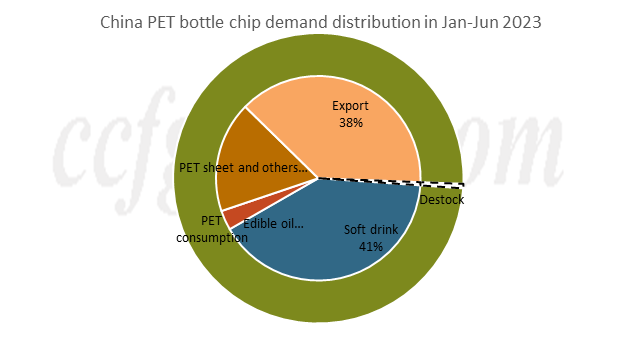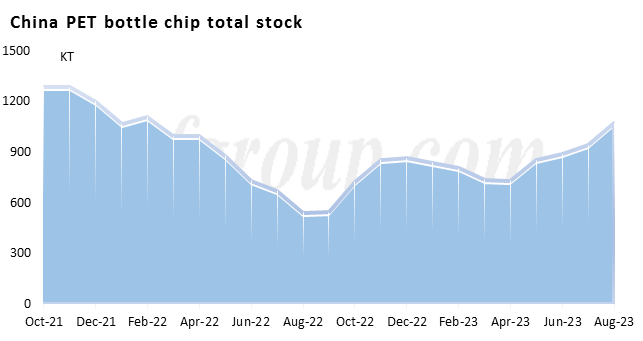PET bottle chip downstream round-up in Jan-Jun 2023
According to CCFGroup statistics, PET bottle chip domestic demand totaled 3.81 million tons in Jan-Jun 2023, y-o-y up 3.1%, back to positive growth again. Soft drink demand for PET has shown a moderate recovery, with a year-on-year growth of 4.9% in the first half of the year, accounting for around 66.3% of domestic demand. Edible oil demand for PET also experienced a reasonable increase, with a year-on-year growth rate of approximately 5.6% in the first half of the year. This growth was mainly attributed to the increased population mobility after the easing of the pandemic, leading to a faster recovery in the tourism and catering industries. However, the overseas market demand has been weak this year, and the favorable effects brought by exports in the past two years have been largely consumed. The total export volume of domestic PET bottle chip from January to June reached approximately 2.38 million tons (estimated based on two tariff codes), showing a year-on-year growth of 3.5%, which marked a significant decline compared to the same period last year. Homogeneous competition among PET sheet producers remains fierce. However, after the industry reshuffling, the demand for virgin PET bottle chip has only experienced a slight decline of 0.9% compared to last year. Overall, the PET bottle chip industry in the first and second quarters benefited mainly from the gradual recovery of domestic market demand. However, due to a decline in export orders, the industry has accumulated a small amount of inventory.


Looking at downstream purchasing rhythm, downstream procurement in the first half of 2023 is basically price-oriented, and there were more pre-purchasing behaviors near the lows. The influence of seasonal factors has weakened. The main driving factors include: 1. Due to the tight domestic supply for most of the previous year and the high spot prices, end-user customers, considering the stability of future supply, mainly made large-scale early purchases and built stock near the lows. As a result, there were fewer follow-up purchases during the price increase. 2. With the expectation of a significant increase in supply due to the planned new capacity expansion, downstream factories and traders were not in a rush to replenish at higher prices.
From a quarterly point of view, there were no new capacity release in the first quarter. However, due to active restocking by downstream customers both domestically and internationally in the fourth quarter of 2022, the PET bottle chip factories had relatively low inventory pressure, and most orders were pre-sold, maintaining a destocking pattern. In the second quarter, due to a temporary halt in export orders and the gradual release of new domestic capacity, the peak procurement season did not truly arrive. However, during this period, the international crude oil price increase led to a rise in domestic polyester raw material costs, which passively pushed up the prices in the PET bottle chip market and triggered several short-term concentrated restocking activities. However, due to the lack of willingness to chase higher prices after the rapid increase, the trading atmosphere in the market was difficult to sustain for long, and most restocking orders remained near the lows.
Considering that soft drinks account for a large proportion of domestic demand, the following review will focus on this product. With the relaxation of policies this year, the operating conditions of soft drink manufacturers nationwide have generally improved. In the first quarter, influenced by the Spring Festival, which includes the New Year and the Chinese Lunar New Year holidays, there were fewer working days, and most beverage companies had already replenished an adequate amount of raw materials, resulting in limited procurement activities during this period. Concentrated restocking mainly occurred in March. In the second quarter, due to the early occurrence of extreme high temperatures in the north, the operating conditions of beverage companies significantly improved compared to the same period last year. In the East and South China regions, production growth continued to take the lead in the first half of the year. However, due to above-average rainfall and slower warming in the southern regions, there were fewer high-temperature days, which affected beverage sales and production. Nevertheless, due to the higher sales targets set by most water companies this year, the production volume of mainstream brands still showed significant growth. The southwestern region was also significantly affected by weather conditions, with limited recovery in operating conditions.
![OATKVFH8]B$Q4{DCBZ[@T_X.png OATKVFH8]B$Q4{DCBZ[@T_X.png](https://pic.ccf.com.cn/2023/08/20230809033028152.png)
![)`K@CQO05]@T(K@D44`)JUI.png )`K@CQO05]@T(K@D44`)JUI.png](https://pic.ccf.com.cn/2023/08/20230809033030746.png)
Soft drink operating rate in 2022-2023
| Region | H1 2022 | H2 2023 | Change |
| Beijing | 76% | 67% | -10% |
| Tianjin | 32% | 77% | 46% |
| Hebei | 67% | 75% | 8% |
| Shanxi | 49% | 63% | 14% |
| Inner Mongolia | 11% | 57% | 46% |
| Liaoning | 49% | 59% | 10% |
| Jilin | 32% | 83% | 51% |
| Heilongjiang | 30% | 70% | 41% |
| Shanghai | 54% | 60% | 6% |
| Jiangsu | 47% | 73% | 26% |
| Zhejiang | 80% | 76% | -3% |
| Anhui | 99% | 68% | -31% |
| Fujian | 82% | 62% | -20% |
| Jiangxi | 65% | 61% | -5% |
| Shandong | 54% | 79% | 24% |
| Henan | 30% | 74% | 44% |
| Hubei | 73% | 57% | -16% |
| Hunan | 79% | 61% | -18% |
| Guangdong | 77% | 72% | -5% |
| Guangxi | 21% | 62% | 41% |
| Hainan | 80% | 96% | 16% |
| Chongqing | 51% | 58% | 7% |
| Sichuan | 67% | 53% | -13% |
| Guizhou | 40% | 52% | 12% |
| Yunnan | 81% | 85% | 4% |
| Tibet | 14% | 25% | 11% |
| Shaanxi | 80% | 66% | -14% |
| Gansu | 37% | 61% | 25% |
| Qinghai | 14% | 68% | 53% |
| Ningxia | 89% | 65% | -24% |
| Xinjiang | 63% | 70% | 7% |
From January to June in 2023, the overall supply and demand pattern of the domestic PET bottle chip market shows a slight trend of inventory accumulation. The domestic sales recovery has been moderate, while the export market has gradually weakened. In the second half of the year, with the concentrated release of new capacity, the pressure on both domestic and export sales of PET bottle chip factories may further intensify, and factory inventories may accumulate again near the end of the year. It is important to pay attention to the changes in plants operation.
- Top keywords
- Cotton Price
- Cotton Futures Price
- Cotton Futures
- CZCE
- PTA Futures Price
- Chemical Fiber
- Polyester Prices
- Wool price
- PTA Futures
- Shengze Silk
- China
- Yarn Price
- price
- China Textile City
- Fibre Price
- Benzene Price
- Cotton
- Index
- Cotton Index
- PTA
- fabric price
- NYMEX
- Top 10
- textile industry
- Spot Cotton
- Cotton Yarn
- Polyester Price
- Futures
- PTA Price
- cotton yarn price

